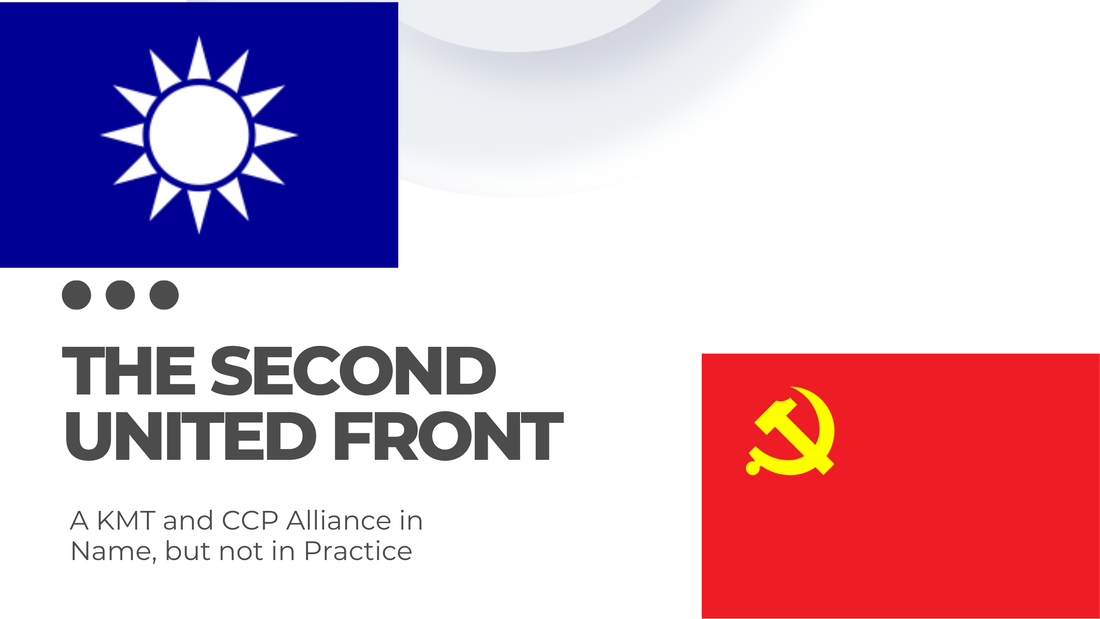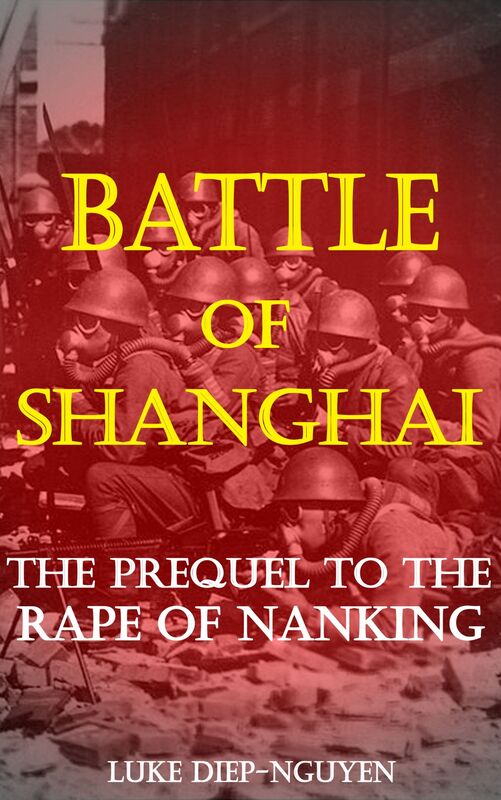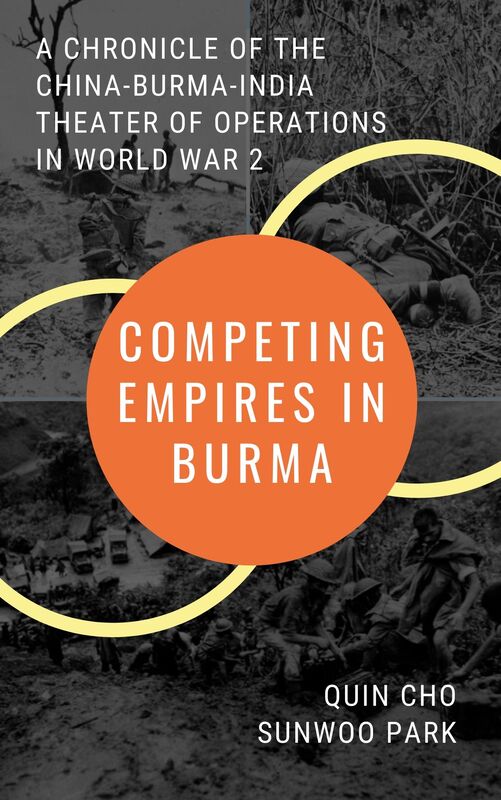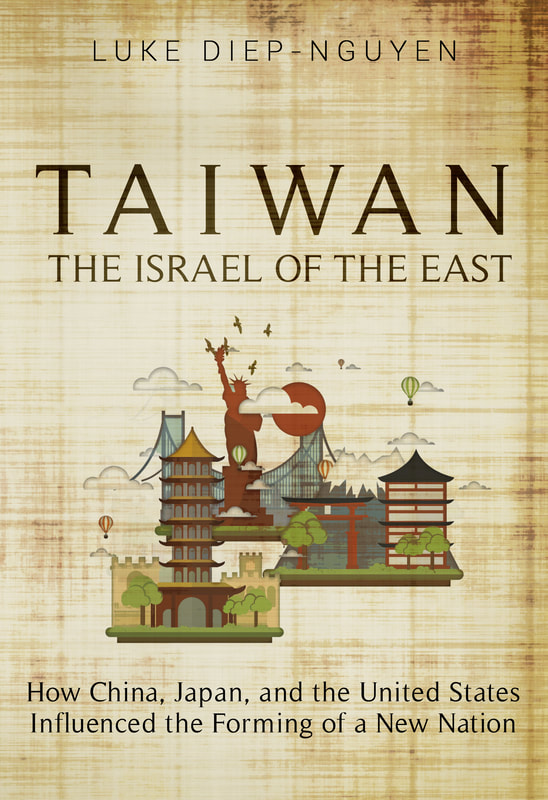|
by Sophia Maroulis The Second United Front* in China was the alliance between the ruling Chinese Nationalist Party or Kuomintang Party (KMT), headed by Chiang Kai-shek, and the Chinese Communist Party (CCP), headed by Mao Zedong. Both parties and several warlords agreed to temporarily cease fighting each other for control of China to work together to combat the invading Imperial Japanese Army during the Second Sino-Japanese War (1937-1945). However, although the KMT and CCP shared a common enemy and were allies in name, in practice, their alliance was fraught with conflict. From the outset, the KMT and CCP were enemies with a long history. A decade prior, Chiang Kai-shek had ordered mass purges of communists, and in 1934 CCP members were forced to retreat in the perilous "Long March" to Northern China, where tens of thousands died (United Front, 1). Moreover, the two parties deeply distrusted each other because of their opposing ideological beliefs and bloody political history. Ultimately in December 1936, in the "Xi'an Incident," Chiang Kai-shek was kidnapped by generals under his command and coerced into allying with the CCP due to the enormous threat Imperial Japan posed (Xi'an Incident, 1). In the first year of the Second Sino-Japanese War, the United Front worked fairly well until the fall of Wuhan in 1938 (Slyke, 126; Gordon, 162). Although the KMT and CCP's armies fought side by side in some battles, the parties generally fought against the Imperial Japanese Army separately and in different parts of China. As the Imperial Japanese Army's strategy shifted from an intense assault to a war of attrition, the parties became more hostile toward each other (Slyke, 126). The KMT was angered by the CCP's guerilla warfare skirmishes in the countryside because it felt that it was unfairly shouldering greater casualties defending cities. At the same time, the CCP took advantage of the KMT's preoccupation with rebuilding itself. The CCP's Eighth Route Army was said to "devote 70 percent of its efforts to organizing the countryside, 20 percent to fighting the Nationalists, and only 10 percent of its efforts against Japan" (Paine, 154). Indeed, throughout the war, the CCP increased its military strength from 25-30 thousand troops to a little over a million (Slyke, 127; Yin, 627). Conversely, the CCP was angry at Chiang Kai-shek for funneling more resources to the KMT and the significantly larger number of troops under his direct command. Chiang—who had about forty armies to provide for compared to the CCP's two armies— did not want to give China's limited resources to the party that was actively trying to overthrow him (Paine, 144, 153). Throughout the war, KMT and CCP armies attacked each other, undermining the notion of a United Front. In January 1941, Nationalists attacked and dismantled the CCP's New Fourth Army's command in what was called the New Fourth Army Incident or the South Anhui Incident. The estimated NFA soldier and non-soldier deaths vary dramatically but tend to range from 2,000-6,000 (Benton, 709). Shortly thereafter, Chiang Kai-Shek referred to the incident as disciplinary action against the NFA's mutiny—referring to the NFA not moving to where the KMT ordered it— and that dismantling the NFA was "a 'military necessity" (Benton, 712). Another strategy the KMT used to weaken its competition was to drive Communists up north to fight the Imperial Japanese Army (IJA) in Japanese-occupied territory so that the two KMT enemies would weaken each other (Gordon, 171). Furthermore, the KMT blockaded the CCP-occupied land to starve them and render their troops immobile to fight against the KMT or IJA (Paine, 157). The CCP similarly undermined the KMT. In October 1940 (a few months before the South Anhui Incident), the NFA attacked a Nationalist garrison of 20,000 soldiers in Huangqiao (Yang, 82). The CCP also attacked KMT guerrilla armies behind Japanese-occupied territory, letting the KMT fight all of the high-casualty and high-stakes battles in cities while spreading their own propaganda to increase civilian support (Paine, 157; Yang, 79). The adage "The enemy of my enemy is my friend" does not accurately describe the KMT and CCP's Second United Front. The parties' attempts to defeat each other undermined their attempts to defeat Japan. Both parties refrained from sending in troops against the IJA when possible to preserve their numbers for ultimately fighting each other. Both parties attacked and sought to eliminate each other. Both parties struggled to garner international aid partly because other nations were doubtful of China's fractured and ineffectual military efforts. Throughout all this, millions of Chinese civilians suffered great casualties, displacement, and war atrocities during the Second Sino-Japanese War at the hands of the Imperial Japanese Army. As soon as the Second Sino-Japanese War ended, the KMT and the CCP resumed fighting for another four years. *So-named because the KMT and CCP had the first United Front in 1924 when they formed a bloc alliance to combat warlords and unify China. References Benton, Gregor. "The South Anhui Incident." The Journal of Asian Studies, vol. 45, no. 4, 1986, pp. 681–720. JSTOR, https://doi.org/10.2307/2056083. Accessed 5 Jul. 2022. Britannica, The Editors of Encyclopedia. "United Front." Encyclopedia Britannica, 18 Sep. 2018, https://www.britannica.com/topic/United-Front-Chinese-history-1937-1945. Accessed 14 Jun 2022. Britannica, The Editors of Encyclopedia. "Xi'an Incident." Encyclopedia Britannica, 5 Dec 2021, https://www.britannica.com/event/Xian-Incident. Accessed 27 Jun 2022. Britannica, The Editors of Encyclopedia. "Second Sino-Japanese War." Encyclopedia Britannica, 10 Nov 2020, https://www.britannica.com/event/Second-Sino-Japanese-War. Accessed 14 Jun 2022. Coogan, Anthony. "Northeast China and the Origins of the Anti-Japanese United Front." Modern China, vol. 20, no. 3, 1994, pp. 282–314. JSTOR, http://www.jstor.org/stable/189201. Accessed 14 Jun 2022. "File: Flag of the Chinese Communist Party.svg." Wikimedia Commons, the free media repository. 20 Apr 2022, 09:21 UTC. 11 Jul 2022, 16:57 <https://commons.wikimedia.org/w/index.php?title=File:Flag_of_the_Chinese_Communist_Party.svg&oldid=650150238>. "File: Flag of the Chinese Communist Party.svg." Wikimedia Commons, the free media repository. 20 Apr 2022, 09:21 UTC. 11 Jul 2022, 16:57 <https://commons.wikimedia.org/w/index.php?title=File:Flag_of_the_Chinese_Communist_Party.svg&oldid=650150238>. Gordon, David M. "The China-Japan War, 1931-1945." The Journal of Military History, vol. 70 no. 1, 2006, p. 137-182. Project MUSE, doi:10.1353/jmh.2006.0052. Paine, S. C. M. The Wars for Asia, 1911–1949, Cambridge University Press, 2012. ProQuest Ebook Central, https://ebookcentral.proquest.com/lib/whitman/detail.action?docID=989182. Van Slyke, Lyman P. "The United Front in China." Journal of Contemporary History, vol. 5, no. 3, 1970, pp. 119–35. JSTOR, http://www.jstor.org/stable/259678. Accessed 14 Jun 2022. Yang, Zi. "The Chinese Communist Party's exploitation of the Second United Front: intelligence and counterintelligence on a Middle Force Territory." Intelligence and National Security, 37:2, 73-89, Doi: 10.1080/02684527.2021.1984017 More on the topic:
0 Comments
Leave a Reply. |
- Home
- Stories
-
Internship
- Summer 2024 Internship
- Summer 2023 Internship
- Fall 2022 Internship
- Summer 2022 Internship
- Summer 2021 Internship
- Fall 2020- Spring 2021 Internship
- Summer 2020 Internship
- Fall 2019 Internship
- Summer 2019 Internship >
- School Year 2018-2019 Internship
- Summer 2018 Internship >
- Fall 2017 Internship
- Summer 2017 Internship >
- Books
- Archives
-
Resource Page
-
Supplementary Research Guides
>
- Unit 731 - Guide >
-
Philippines' Resistance - Guide
>
- Philippines World War II Timeline
- The Japanese Invasion & Conquest of the Philippines
- Bataan Death March
- Formation of Underground Philippines Resistance
- Supplies of the Guerrilla Fighters
- The Hukbalahap
- Hunter's ROTC
- Marking's Guerrillas
- United States Army Forces in the Philippines of Northern Luzon (USAFIP-NL)
- The Aetas
- Chinese and Filipino-Chinese Nationalist Guerrilla Units
- The Female Faces of the Philippine Guerrillas
- Rising Sun Flag - Guide >
- Pinay Guerrilleras - Guide >
- Fall of Singapore - Guide >
- Three Years and Eight Months - Guide >
- Siamese Sovereignty - Guide >
- The Khabarovsk War Crimes Trial - Guide >
- Unit 731 Cover-up : The Operation Paperclip of the East - Guide >
- Marutas of Unit 731 - Guide >
- Prince Konoe Memoir - Guide >
- Competing Empires in Burma - Guide >
- Battle of Shanghai - Guide >
- Ishi Shiro - Guide >
- Taiwan The Israel of the East - Guide >
- Seeking Justice for Biological Warfare Victims of Unit 731 - Guide >
- Rice and Revolution - Guide >
- Clash of Empires - Guide >
-
Hunger for Power and Self-SufficiencyI - Guide
>
- The Influence of War Rations on Post-War Culinary Transformations
- How World War II Complicated Food Scarcity and Invention
- American Military Innovations
- Government-Sponsored Food Inventions in Europe during World War II
- Feeding the Army: The Adaptation of Japanese Military Cuisine and Its Impact on the Philippines
- Mixed Dishes: Culinary Innovations Driven by Necessity and Food Scarcity
-
Denial A Quick Look of History of Comfort Women and Present Days’ Complication - Guide
>
- The Comfort Women System and the Fight for Recognition
- The Role of Activism and International Pressure
- The Controversy over Japanese History Textbooks
- The Sonyŏsang Statue and the Symbolism of Public Memorials
- Activism and Support from Japanese Citizens
- The Future of Comfort Women Memorials and Education
- Echoes of Empire: The Power of Japanese Propaganda - Guide >
- Lesson Plans >
-
Supplementary Research Guides
>
|
Pacific Atrocities Education
730 Commercial Street San Francisco, CA 94108 415-988-9889 |
Copyright © 2021 Pacific Atrocities Education.
We are a registered 501 (c)(3) charity. |
- Home
- Stories
-
Internship
- Summer 2024 Internship
- Summer 2023 Internship
- Fall 2022 Internship
- Summer 2022 Internship
- Summer 2021 Internship
- Fall 2020- Spring 2021 Internship
- Summer 2020 Internship
- Fall 2019 Internship
- Summer 2019 Internship >
- School Year 2018-2019 Internship
- Summer 2018 Internship >
- Fall 2017 Internship
- Summer 2017 Internship >
- Books
- Archives
-
Resource Page
-
Supplementary Research Guides
>
- Unit 731 - Guide >
-
Philippines' Resistance - Guide
>
- Philippines World War II Timeline
- The Japanese Invasion & Conquest of the Philippines
- Bataan Death March
- Formation of Underground Philippines Resistance
- Supplies of the Guerrilla Fighters
- The Hukbalahap
- Hunter's ROTC
- Marking's Guerrillas
- United States Army Forces in the Philippines of Northern Luzon (USAFIP-NL)
- The Aetas
- Chinese and Filipino-Chinese Nationalist Guerrilla Units
- The Female Faces of the Philippine Guerrillas
- Rising Sun Flag - Guide >
- Pinay Guerrilleras - Guide >
- Fall of Singapore - Guide >
- Three Years and Eight Months - Guide >
- Siamese Sovereignty - Guide >
- The Khabarovsk War Crimes Trial - Guide >
- Unit 731 Cover-up : The Operation Paperclip of the East - Guide >
- Marutas of Unit 731 - Guide >
- Prince Konoe Memoir - Guide >
- Competing Empires in Burma - Guide >
- Battle of Shanghai - Guide >
- Ishi Shiro - Guide >
- Taiwan The Israel of the East - Guide >
- Seeking Justice for Biological Warfare Victims of Unit 731 - Guide >
- Rice and Revolution - Guide >
- Clash of Empires - Guide >
-
Hunger for Power and Self-SufficiencyI - Guide
>
- The Influence of War Rations on Post-War Culinary Transformations
- How World War II Complicated Food Scarcity and Invention
- American Military Innovations
- Government-Sponsored Food Inventions in Europe during World War II
- Feeding the Army: The Adaptation of Japanese Military Cuisine and Its Impact on the Philippines
- Mixed Dishes: Culinary Innovations Driven by Necessity and Food Scarcity
-
Denial A Quick Look of History of Comfort Women and Present Days’ Complication - Guide
>
- The Comfort Women System and the Fight for Recognition
- The Role of Activism and International Pressure
- The Controversy over Japanese History Textbooks
- The Sonyŏsang Statue and the Symbolism of Public Memorials
- Activism and Support from Japanese Citizens
- The Future of Comfort Women Memorials and Education
- Echoes of Empire: The Power of Japanese Propaganda - Guide >
- Lesson Plans >
-
Supplementary Research Guides
>



